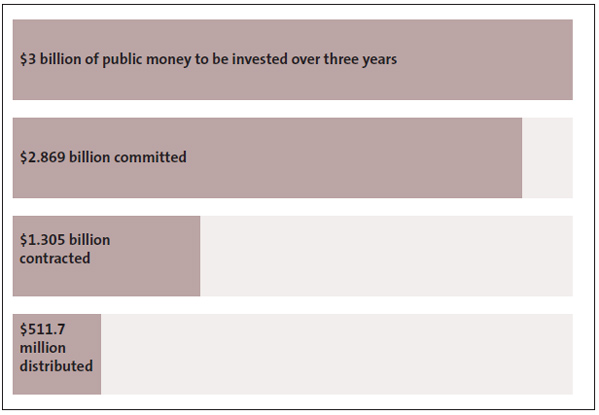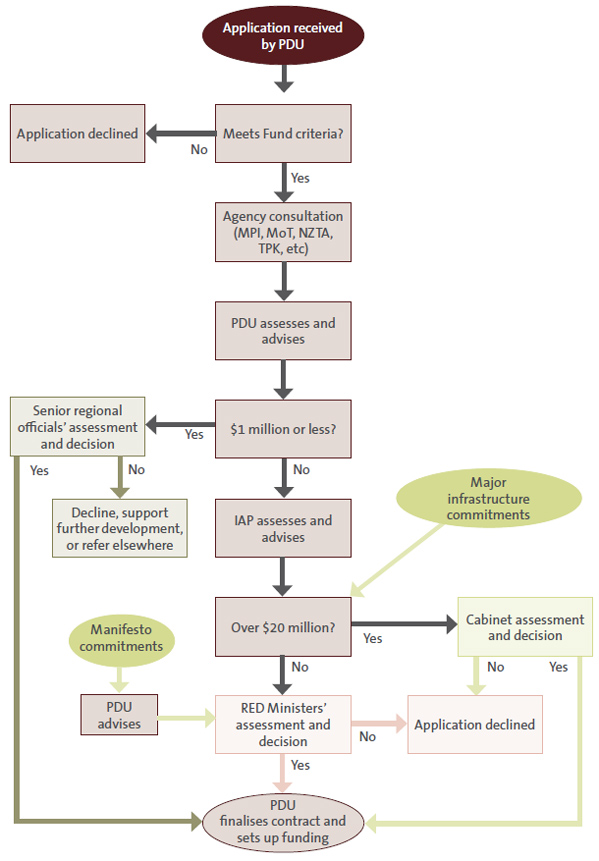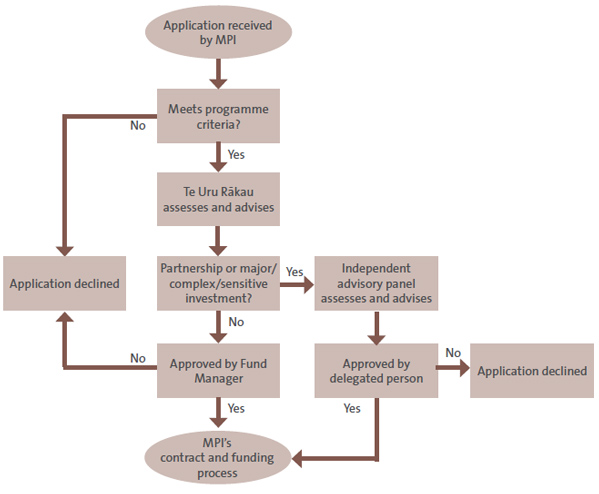Appendix 2: About the Provincial Growth Fund
What is the Provincial Growth Fund?
The Fund is a three-year programme that was launched in February 2018. When it was set up, three stages were planned:53
- Stage 1 (pre-investment) – a focus on generating investment opportunities, work and employment readiness, and building a pipeline of infrastructure investments.
- Stage 2 (funding decisions) – when most investment decisions would be made (once feasibility studies and business cases had been prepared).
- Stage 3 (project delivery) – when most projects would be under way.
Some funding has been invested in projects (such as forestry projects) that are not expected to be completed in three years and in loans and other funding arrangements that might not be concluded in three years. Some arrangements might involve funds being returned and re-invested or written off.
Provincial Growth Fund Limited, a Crown-owned company, has been set up to manage loan and equity investments that will continue beyond the Fund's three-year period. As the Fund enters its third year, and investments are reviewed to see whether funding is invested where it has most effect, the mandate of the company is also being reconsidered in light of the potential role it might play in the Government's infrastructure programme.
The Fund has been allocated through a combination of initiatives prioritised by the regions, proposals brought forward by sector groups, and manifesto and infrastructure initiatives prioritised by the Government. There is no set period for applications to be submitted, nor are there funding rounds for applications. Applications that meet the Fund's criteria are considered on their merits, as they are submitted.
As Figure 3 shows, as at 31 March 2020:
- Of the $3 billion, the total funding committed54 was nearly $2.9 billion.
- Of the committed funding, just over $1.3 billion had proceeded to a signed contract.55
- Of the funding under contract, the total funding distributed was just over $500 million.
Figure 3
Total funding committed, contracted, and distributed, as at 31 March 2020, including the costs of administering the Provincial Growth Fund
This figure shows that, of the $3 billion of public money to be invested over three years, $2.869 billion was committed, $1.305 billion had been contracted, and $511.7 million had been distributed.

Source: Ministry of Business, Innovation and Employment.
Where is the money going?
As at 31 March 2020, about 51% of the nearly $2.9 billion committed funding was to projects in the surge regions:
- Tai Tokerau/Northland – $556.9 million (19.4% of the total amount committed);
- Bay of Plenty – $228.0 million (7.9% of the total amount committed);
- Tairāwhiti/East Coast – $236.5 million (8.2% of the total amount committed);
- Hawke's Bay – $145.4 million (5.1% of the total amount committed);
- Manawatū-Whanganui – $162.3 million (5.7% of the total amount committed); and
- West Coast – $145.4 million (5.1% of the total amount committed).
The amount committed at that stage to the other regions (excluding multi-regional and national projects, and other spending) was $454.5 million (15.8%).
Another $98.7 million (3.4%) was committed to multi-regional projects (that is, projects spanning more than one region), and $22.7 million to "other spending". We plan to complete further work to examine the nature of, and processes supporting, "other spending". There was also $818.7 million (28.5%) categorised as "national". Of this, just more than $584 million was ring-fenced for use in particular areas, and just less than $234.5 million for specific projects. "National" includes:
- $155.2 million in operating costs for the Fund's three-year period, which is for the PDU ($112 million) and the Ministry for Primary Industries ($43.2 million). As at 31 March 2020, $81.9 million had been spent: PDU ($47.6 million) and the Ministry for Primary Industries ($34.3 million);
- funding for projects that, although benefitting regions, are national in application (such as $5.7 million for a project to protect the term "Manuka honey");
- funding that has been ring-fenced for a particular purpose such as energy or waste/recycling, or the Whenua Māori programme, and is held nationally by the PDU, until it is drawn down for particular projects. As particular projects are approved and contracted, the funding for it "migrates" from the ring-fenced "national" category to the region involved (as at 31 March 2020, $232.9 million was still in the "national" category);
- funding for sectors including rail ($191.5 million), forestry ($147.8 million), tourism ($21.6 million), information communications technology (ICT) and digital connectivity ($19.8 million), and conservation (Predator-free 2050, $19.5 million), which is under the administrative control of the relevant agencies, not the PDU; and
- $30 million that was approved by Cabinet in 2018 for "manifesto commitments to the regions" and was increased in 2019 by another $40 million for "emerging priorities through the Provincial Growth Fund".56
Managing the Provincial Growth Fund
In February 2018, Cabinet agreed operational details for the Fund, including setting up the Regional Economic Development Unit (now called the PDU) in MBIE. The PDU was created from a group that had managed regional economic growth work in MBIE before the Fund was announced.
Cabinet tasked the PDU with "overseeing all the remaining design work for the Fund, administering the Fund and monitoring its operation, working with other government agencies",57 maintaining a complete picture of all initiatives that are supported by the Fund.58 It was to:
... develop a plan for evaluating the operation and effectiveness of the Fund, including further work on Fund outcomes and baseline performance measures. A substantive evaluation of the Fund is intended to be completed by the end of 2020, to inform Ministers of progress in the context of making funding decisions for Budget 2021.59
Managing major forestry and road and rail projects
The Ministry for Primary Industries manages the One Billion Trees programme, which is part of the Fund. Te Uru Rākau, a business unit in the Ministry for Primary Industries, supports the delegated responsibility for the One Billion Trees programme to the Minister of Forestry. One of Te Uru Rākau's responsibilities is managing the One Billion Trees programme. Te Uru Rākau "designs, administers and monitors the One Billion Trees Fund, in consultation with other government agencies",60 using "criteria and performance measures aligned with the Fund, plus some additional criteria specific to the programme".61
Ministers:
... will set clear direction on criteria and performance measures that are consistent with those of the Fund as a whole, and will include requirements to deliver training and employment opportunities and address infrastructure impacts of the investment in the sector. The Ministry for Primary Industries will report to Ministers on its achievement against these criteria as part of the Fund's regular reporting.62
Existing decision-making processes are used, where possible, for infrastructure investments such as rail and roading projects.
Major road and rail projects are managed by the New Zealand Transport Agency and KiwiRail, respectively. They use the usual funding processes and systems for other major road and rail projects in selecting which projects to support, and in managing them.
Overseeing the Provincial Growth Fund
Cabinet papers record that the Fund was designed to be "overseen by a group of Regional Economic Development Ministers",63 "with an Independent Advisory Panel to support assessment of larger applications, ensure sound decision making and provide commercial expertise particularly for the higher value projects".64
The oversight group consisted of Ministers holding the following portfolios: Regional Economic Development, Economic Development, Agriculture, Tourism, Māori Development, Transport, Environment, Local Government, Climate Change, and Employment. Its main mandate was "to monitor overall performance of the Fund to ensure overall objectives are being met and for Ministers to discuss opportunities in the regions".65 However, the oversight group met only once.66
Since that one meeting, the Cabinet Economic Development Committee has played the oversight role. The PDU reports to that Committee every four months, providing information such as:
- a breakdown of funding by agency, sector, and region to show the balance of the portfolio and the stage of investment activity (that is, committed, approved (awaiting a signed contract), contracted, and distributed);
- major announcements and key activities during the period;
- commentary on how activity/outcomes have contributed to the Fund's indicators of effectiveness (reporting for which is currently under development); and
- the focus of activity for the forthcoming period.
As well as the Cabinet Economic Development Committee, there are standalone meetings between Ministers whose portfolio responsibilities overlap, so that activities and interests can be discussed and co-ordinated (for example, the Fund's investment in waste-related or energy projects).
Making funding decisions
The RED Ministers group consists of Ministers with portfolios for Finance, Regional Economic Development, Economic Development, and Transport. The group has the highest level of delegation for making funding decisions. Decisions are delegated, in every case except for the One Billion Trees programme,67 according to the size of the proposed project to the:
- senior regional officials for projects up to $1 million; and
- RED Ministers, in consultation with portfolio Ministers, for projects between $1 million and $20 million.
Cabinet makes the decisions about individual applications of $20 million or more. Regional transport projects are subject to the same delegations as the PDU-managed projects.68
The delegation for the One Billion Trees programme under the Fund operates differently. In February 2018, Cabinet agreed to use existing decision-making processes, where possible, for forestry and infrastructure investments. Cabinet delegated responsibility for the One Billion Trees programme to the Minister of Forestry.69 For the One Billion Trees programme, grants and "partnership funding"70 allocation processes:71
- the Director-General of the Ministry for Primary Industries makes decisions about grants and partnership fund projects up to $2 million;
- the Minister of Forestry, the Minister for the Environment, and the Minister of Finance, in consultation with other Forestry Ministers, make decisions about partnership fund projects between $2 million and $20 million; and
- Cabinet makes decisions about partnership fund projects that are more than $20 million.
Independent advice to Ministers
Cabinet directed an Independent Advisory Panel (IAP) to be set up, which would support the assessment of applications that were more than $1 million. The IAP would ensure sound decision-making and provide commercial expertise. The Cabinet paper said that the IAP "will provide independent advice on proposed investments, and … on the balance of the portfolio of investments".72 The IAP meets monthly and provides advice to the RED Ministers.
How is the money distributed?
The Fund uses a variety of funding arrangements. As well as grants, there can be:
- loans (where the applicant will pay back the Crown);
- equity (where the Crown will take up an interest in the project, becoming a part owner);
- underwriting (where the Crown would buy an asset or guarantee the applicant funding if the applicant cannot dispose of the asset); and
- bespoke contracts (for example, contracts involving leasing land to be able to plant trees as part of the One Billion Trees programme).
As at 31 March 2020, almost all the PDU's 490 funding arrangements were grants (85%) and loans (13%), with only nine equity funding arrangements and no underwriting agreements.
Figures 4 and 5 show the processes used by the PDU and the Ministry for Primary Industries (for the One Billion Trees programme) to process applications.
Figure 4
How the Provincial Development Unit processes applications
The flow chart shows how an application is managed by the Provincial Development Unit, up to the point that a contract is signed and funding arrangements are set up.

Manifesto contingency funding was set aside by the Government for commitments made as part of the manifesto/coalition agreements and emerging priorities. The PDU provides advice (but not a recommendation) on projects considered by the RED Ministers for funding from the manifesto contingency.
Major infrastructure commitments (principally New Zealand Transport Agency projects and investments in KiwiRail) are supported by existing and extensive business cases, assessment, and funding processes. The usual funding processes and systems for other major road and rail projects are used in selecting which projects to support, and in managing them.
In February 2019, the Government announced that $100 million from the Fund would be allocated towards projects that support Māori landowners to develop their land.73
Applications for these Whenua Māori projects are administered by the PDU, and proceed to the RED Ministers, in consultation with the Minister of Agriculture, the Minister for the Environment, and the Minister for Māori Development, for a decision.
Figure 5
How the Ministry for Primary Industries processes applications
The flow chart shows how an application is managed by the Ministry for Primary Industries, up to the point that a contract is signed and funding arrangements are set up.

53: Cabinet paper (February 2018), Operational design of the Tuawhenua Provincial Growth Fund, at pages 4-5.
54: "Committed funding" is the sum of approved projects (announced and unannounced), unspent allocations, contingencies, and operating expenditure. "Allocations" are determined by Cabinet and/or Ministers.
55: Data provided by MBIE. The amounts shown are for the Fund's duration to date and include departmental costs for the PDU and the Ministry for Primary Industries.
56: About two-thirds of this funding has been drawn down for projects that are agreed by the RED Ministers. As at 31: March 2020, there was $24.7 million remaining in the contingency funding. Cabinet agreed that the remainder would be drawn down by the PDU for pandemic response initiatives. The funding has been drawn down.
57: Cabinet paper (February 2018), Operational design of the Tuawhenua Provincial Growth Fund, page 2.
58: Cabinet paper (February 2018), Operational design of the Tuawhenua Provincial Growth Fund, page 13.
59: Cabinet paper (February 2018), Operational design of the Tuawhenua Provincial Growth Fund, page 13.
60: One Billion Trees Fund application form, page 1 at teururakau.govt.nz.
61: Cabinet paper (February 2018), Operational design of the Tuawhenua Provincial Growth Fund, page 1.
62: Cabinet paper (February 2018), Operational design of the Tuawhenua Provincial Growth Fund, at page 9.
63: Cabinet paper (December 2017), The Provincial Growth Fund at paragraph 34.
64: Cabinet paper (December 2017), The Provincial Growth Fund at page 2.
65: Cabinet paper (December 2017), The Provincial Growth Fund at page 6.
66: Cabinet paper (August 2018), Further decisions on the Provincial Growth Fund at page 2.
67: The PDU receives and processes applications related to forestry, such as wood processing. But an application that is clearly about planting and managing forests would be referred to the One Billion Trees programme.
68: Cabinet paper (August 2018), Further decisions on the Provincial Growth Fund at page 11.
69: Cabinet paper (February 2018), Operational design of the Tuawhenua Provincial Growth Fund, page 1.
70: See Te Uru Rākau's website at www.teururakau.govt.nz. "Partnership funding" is a co-funding arrangement available to any individual, non-government organisation, catchment group, Māori organisation, company, charity, research organisation, or council. Applicants will typically need to contribute 50% of the cost towards the project, either as a financial share or "in kind". Applicants can apply for grant funding at the same time.
71: CAB-18-MIN-0379.01, The One Billion Trees Programme: Actions and Decisions for Implementation at page 7.
72: Cabinet paper (February 2018), Operational design of the Tuawhenua Provincial Growth Fund, page 2.
73: See www.growregions.govt.nz.

